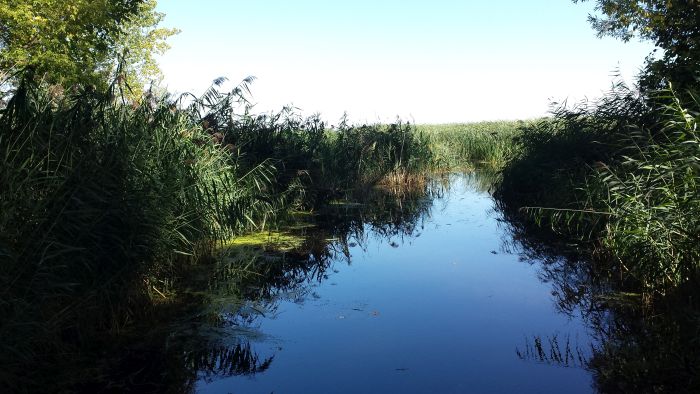
Kewaunee County Invasive Species Management
With funding from the EPA Great Lakes Restoration Initiative (GLRI), the Bay-Lake RPC will treat at least 1,000 acres of invasive Phragmites, Wild parsnip, and Japanese knotweed in Kewaunee County from 2018-2020 and help the County to establish a permanent management strategy.
The invasive species treatment will be conducted under Chemical Aquatic Plant Control from the Wisconsin Department of Natural Resources.
Inventory of Invasive Species Locations
The Bay-Lake RPC is currently collecting public input on the locations of the target invasives in the county. For each location reported, a landowner permission form must be provided.
RFQ for Herbicide Treatments
The Bay-Lake RPC released its Request for Qualifications (RFQ) on January 20, 2020 for the treatment of invasive Phragmites, Wild parsnip, and Japanese knotweed in Kewaunee County in 2020. Responses to this request are due March 13, 2020 at 4:30PM CDT. Any questions posed in response to the request will be posted here.
Received Questions and Responses
Q) The bid sheet indicates less acreage for all 3 species, particularly Phragmites, than what is listed in the estimated summary. If the acreage to be treated is less, how are the sites to be treated being chosen?
A) The bid sheet indicates less acreage because we have extended the initial grant award from 2018 & 2019, to treat the remaining goal in 2020. The sites will be prioritized in larger colonies, and properties who have not received treatment.
Q) Can we get shapefiles of each site to be treated or is that data not available?
A) We don’t have the final particular sites to be treated, however we can provide shapefiles of our invasive species inventory and past treatments if the contractors wish to obtain these.
Q) Are these sites all follow-up treatment that were treated the last two years?
A) In short, they are not all follow-up treatments. Eventual treatment sites will be dependent on permission forms that we will need to obtain since this is an extension of the initial grant.
Q) Is it the contractor’s responsibility to locate organic farms or places of organic business?
A) No. These have already been located at the start of the project, parcels that were deemed to be organic businesses are shown in red on the contractor’s map.
Q) Is it the contractor’s responsibility to locate any apiaries?
A) No. These have already been located at the start of the project, parcels that were deemed to be apiaries are shown in red on the contractor’s map.
Q) With regards to the first two questions, will treatment sites with a given (x) amount of feet from those locations be eliminated from the contractors responsibility?
A) These sites will not be treated unless private landowner gives permission. A buffer was created around the parcels of the first two questions and is shown in red on the contractor’s map.
Q) With regards to Japanese Knotweed, can we pick a different application method than those listed? (Injection or mow down and pour I believe are listed?)
A) Bay-Lake RPC is open to discussing different chemical and mechanical controlling methods.
Q) With regards to different species treatment. Will we be able to treat Wild Parsnip in June?
A) Yes.
Q) With regards to invoicing. Are we able to invoice for each species separately, upon completion?
A) Yes.
Q) With regards to GPS/GIS. Will we be required to submit polygon shapefiles for ROW sites?
A) Yes.
Q) Are sites labeled with an ID number? It would help with herbicide reporting and record keeping.
A) No. If needed we can provide each invasive species polygon with a unique number for reporting and record keeping, however contractors are encourage to treat unmarked invasive species stands within given permission parcels and within the ROW that is not shown on the map.
Q) If funding is available to do mowing, what species is priority?
A) Mowing is completed by the highway departments and individually by 4 towns. Our priority species is Phragmites. Funding is available for chemical and mechanical control methods.
Q) In certain areas along waterways where suitable ice conditions may not form, would those areas be eliminated from mowing?
A) Treatments are performed in summer and early fall, there will likely not be ice conditions.
Q) Would shredding/knocking down with tracks be sufficient enough for mowing operations? We have done this in the past with great success. We can elaborate in our bid.
A) We are open to other control methods if they are chemical or mechanical.
Q) Is August 31st a hard deadline? Or if more property permissions come in would it be extended?
A) No, but we prefer having permission forms by August 31, 2020, to guarantee they are in our system. We hope to treat in September. We will accept permission forms up until treatment for Phragmites and Japanese Knotweed takes place.
Q) When is the last day you will be accepting permissions?
A) August 31, 2020.
Q) What is the earliest start date allowed for Phragmites control work?
A) September 1, 2020.
Have questions? Please contact:
Madison Smith, Environmental Planner
Phone: (920) 448-2820, Ext. 106
Email: MSmith@baylakerpc.org
